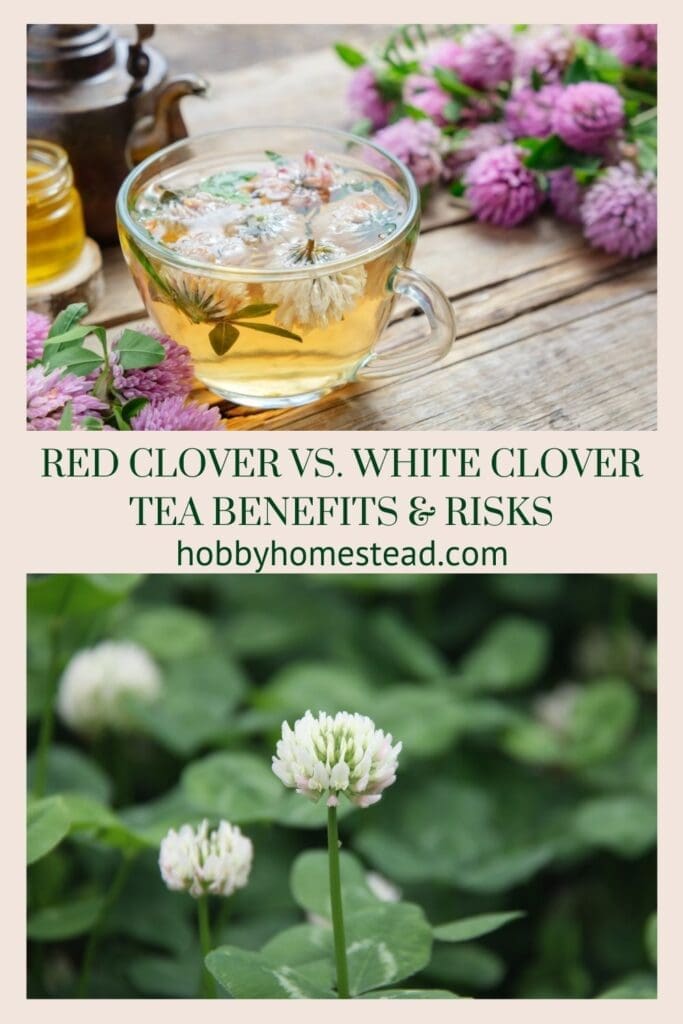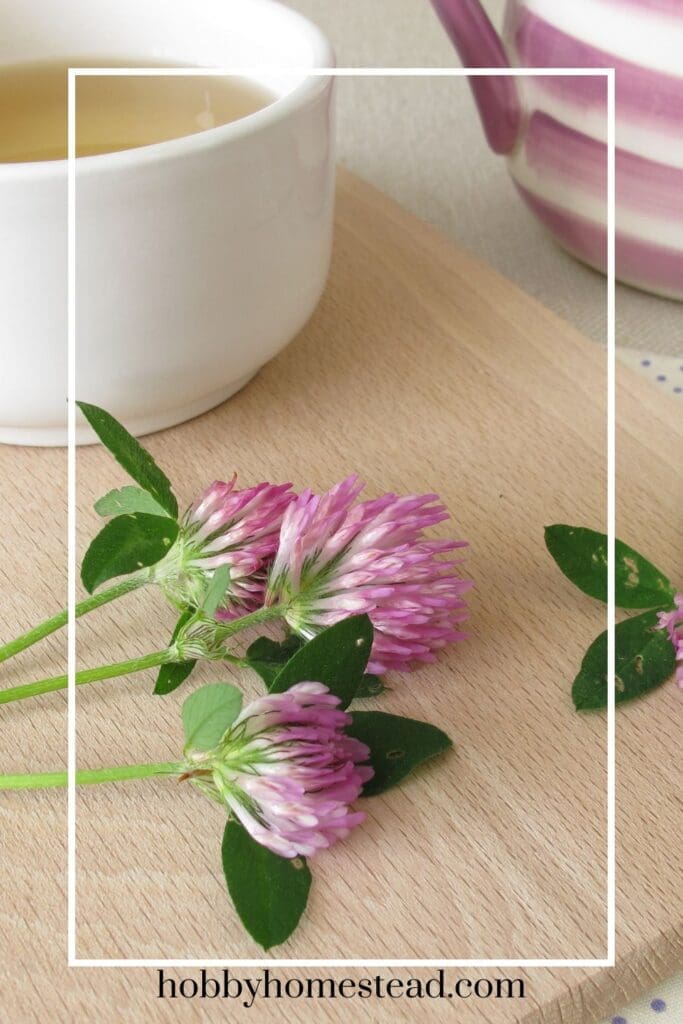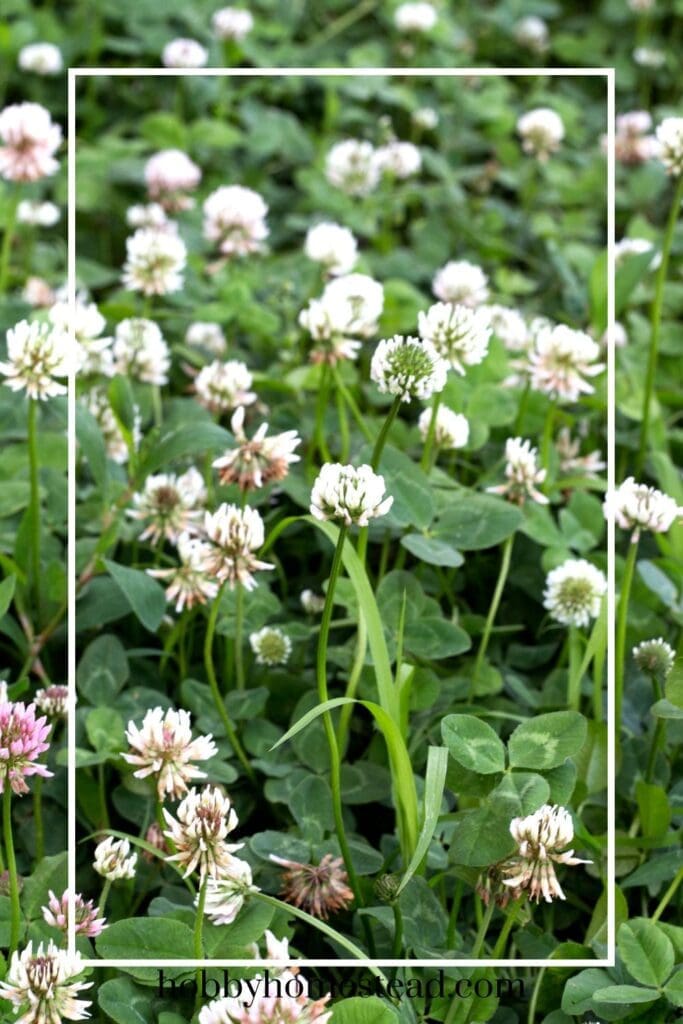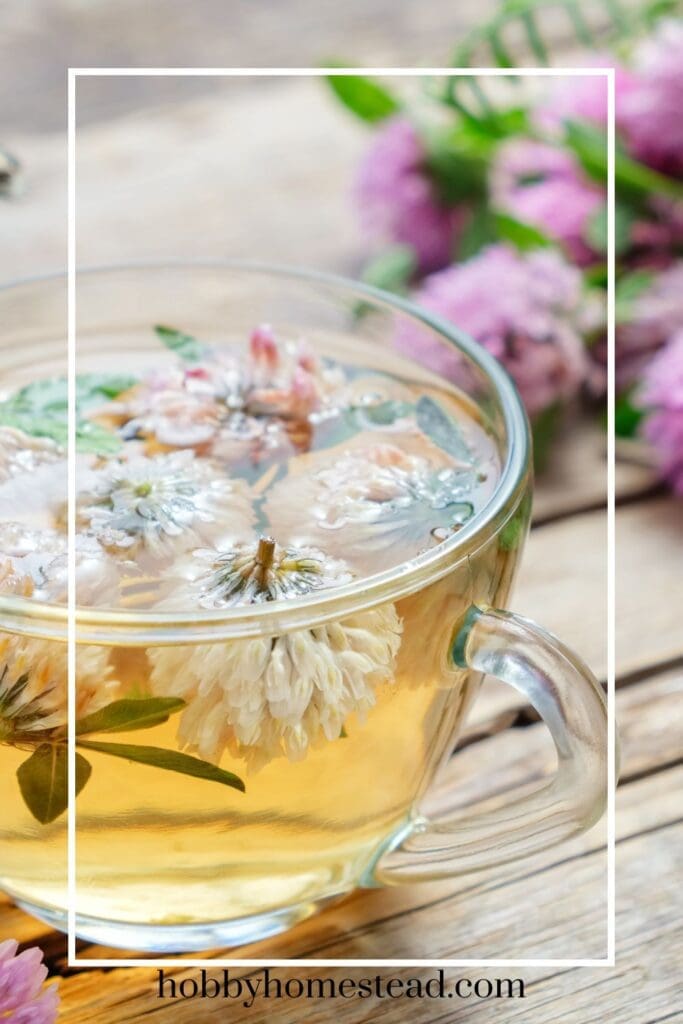Last updated on August 3rd, 2025 at 11:24 am
If you’ve ever wondered about Red Clover vs. White Clover and which one makes the better herbal tea? Or the better choice for your homestead. This guide will help you sort it all out.
This year, our backyard exploded with clover. Especially red and white varieties. My daughter and her friend started drying flower heads to make homemade clover tea, which led us to dig deeper into the different types of clover, their benefits, and the risks of using them. Whether you’re harvesting clover from a backyard clover lawn or growing it as a cover crop, it’s helpful to know what each species offers. Especially if you’re planning to drink it.
Let’s explore red clover vs. white clover, and other species of clover you might encounter. We’ll also go over the best way to harvest, dry, and brew clover tea safely.

What Is Clover?
Clover is a low-growing, hardy plant in the legume family (Trifolium). There are over 250 known clover species, and they grow all across the United States in pastures, lawns, and even poor soil. Some are perennial plants, while others are annual clover types that live only one season.
Clover is known for its role in:
- Nitrogen fixation (turning atmospheric nitrogen into a usable form for plants)
- Soil improvement and erosion control
- Use as a cover crop or green manure
- Clover lawns or low-maintenance clover yards
- Tea, especially from red or white clover flower heads
Clover thrives in full sun, well-drained soils, and grows best in early spring through early summer depending on the type of clover and soil conditions.
Red Clover (Trifolium pratense)
Appearance & Growth
Red clover is a short-lived perennial that often acts like a biennial or annual plant in extreme cold climates. It has purple flowers, oval leaflets, and a deep taproot that helps it grow in poor soil and alkaline soils.
It usually blooms from late spring to early summer and grows taller than white clover, with a larger leaf size and prominent seed head.
Commonly used as a forage crop, red clover is also planted as a cover crop or clover plot for nitrogen fixation and high yields. Red clover seed is often mixed with perennial ryegrass, tall fescue, or other grass seed for pasture.
Tea Benefits
Red clover tea has a strong, earthy flavor. People have used it traditionally for:
- Menopause symptom relief (due to its plant estrogens or isoflavones)
- Soil detoxification (herbalists believe it has blood-cleansing properties)
- Skin conditions like eczema
- Cough and cold support
It’s rich in nutrients and antioxidants, which is why many herbal tea blends use the leaves of red clover and its individual flowers.
Risks and Warnings
Red clover isn’t for everyone. Because of its estrogen-like compounds, it may not be safe for:
- Pregnant or breastfeeding women
- People with hormone-sensitive conditions
- Anyone on blood thinners (it can act like a natural anticoagulant)
Always consult a doctor or herbalist before drinking red clover tea regularly. It’s also important to avoid collecting red clover from areas sprayed with broadleaf herbicides or near roadsides.

White Clover (Trifolium repens)
Appearance & Growth
White clover is a perennial clover with white flowers, often found in grass lawns, clover lawns, and food plots. It’s a low-growing, spreading plant that handles close grazing and foot traffic well. Making it a good choice for sustainable clover yards.
It blooms from early spring through late fall, and tolerates a variety of soil types, including wet soils and dry summers. White clover varieties, like White Dutch clover and Micro clover, are popular in clover lawn pros and cons discussions due to their resilience and eco-friendly nature.
Tea Benefits
White clover tea has a milder, sweeter flavor than red clover. It’s traditionally used to:
- Support the immune system
- Help with fevers and colds
- Act as a mild detoxifier
- Soothe inflammation
You can dry the white clover flowers and leaves to make a calming herbal infusion.
Safety and Use
White clover is generally safer than red clover for regular use. However:
- Avoid clover from treated lawns or sprayed fields
- Don’t overharvest from a clover lawn. Leave plenty for the bees.
- Introduce new teas slowly to make sure there are no allergic reactions
Other Types of Clover
Here are a few other clover species you might come across:
Crimson Clover (Trifolium incarnatum)
- An annual plant with beautiful red flowers
- Often grown in late winter or early fall as a cover crop
- Helps with erosion control and nitrogen fixation
- Not commonly used in teas
Arrowleaf Clover
- Popular in the southern United States
- Grows best in mild winters
- Tall plant with arrow-shaped leaves
- Used as a forage crop, not tea
Strawberry Clover
- Closely related species to red and white clover
- Grows well in wet soils
- Pretty pink flowers, but not common in herbal teas
Subterranean Clover
- A winter annual used in crop rotation
- Good for grass pastures and high clover leys
- Not typically used for tea or culinary purposes
Berseem Clover
- High biomass annual clover used in green manure systems
- Great for vegetable garden soil prep
- Also not used in teas
How to Harvest and Dry Clover for Tea
Best Time. Harvest clover in early summer or late spring, after the morning dew dries.
Choose Carefully. Only harvest from untreated, pesticide-free areas.
Collect. Snip flower heads and a few tender leaves from red or white clover.
Drying. Spread clover on a screen or paper towel in a dry, shady spot. Flip daily.
Storage. Once fully dry, store in an airtight container away from light and moisture.
Can I use any type of clover for tea?
No. Only specific clover species like red clover (Trifolium pratense) and white clover (Trifolium repens) are commonly used in teas. Avoid other types like arrowleaf clover or subterranean clover, which aren’t traditionally consumed and may not be safe.
How to Make Clover Tea
- 1 Tbsp dried clover flowers (red or white)
- 8 oz hot water
- Steep 10–15 minutes
- Optional: sweeten with honey or combine with lemon balm or mint
Use about 1–2 cups per day. Start with small amounts and monitor how you feel.

Which Clover Is Right for You?
- Red clover is bold in flavor and rich in isoflavones. But use with caution.
- White clover is milder and generally safer for daily drinking.
- Both grow beautifully in clover lawns or as cover crops, and support soil improvement through nitrogen fixation.
- There are many types of clover, but only a few are good for tea.
When it comes to foraging or harvesting from your own clover plot, always make sure to identify the type of clover, consider your growing season, and know the risks and benefits before making it part of your regular routine.
Benefits of Clover Lawns
Clover lawns aren’t just a charming addition to your yard—they’re a functional, low-maintenance, and eco-friendly alternative to traditional grass lawns. Whether you’re growing white clover, micro clover, or even a mix of clover seed and grass seed, the benefits go far beyond aesthetics. Here’s why so many homesteaders and gardeners are making the switch:
🐝 They Support Pollinators
Unlike traditional grass lawns, which offer little to no food for insects, clover lawns are filled with blooms. Red clover, white clover flowers, and even crimson clover attract bees, butterflies, and other beneficial pollinators—helping support biodiversity right in your own backyard.
🛠 Less Maintenance
While perennial ryegrass or tall fescue lawns often require weekly mowing during the growing season, clover lawns grow low and dense, reducing the need for frequent trimming. That means more time spent enjoying your yard and less time maintaining it.
🐇 Natural Pest Control
Clover is a hardy plant that resists many pests naturally. It can also act as a decoy crop—drawing deer and rabbits away from your vegetable garden or delicate ornamentals. Plus, clover species can outcompete many common weeds, reducing your reliance on broadleaf herbicides.
💧 Lower Watering Needs
Grass lawns are notorious for their thirst—especially in dry summers. But clover plants are drought-tolerant and require much less water. Thanks to their deep taproots and adaptability to different soil types, they thrive in well-drained soils, wet soils, and everything in between.
🌱 Soil Improvement
Clover is a perennial legume, meaning it works to fix nitrogen in the soil through root nodules. This not only creates a green lawn that needs no synthetic fertilizers, but it also boosts soil health for nearby crops. That’s why clover is a common choice for green manure, crop rotation, and clover plots.
🏞 Grows in Challenging Spots
From alkaline soils to shady patches, clover can handle tough conditions where grass struggles. Whether it’s the edges of a path, near outbuildings, or low-lying damp areas, clover offers a good choice for establishing new plants where other options fail.
Is red clover safe to drink every day?
Red clover contains plant estrogens (isoflavones) that can act like hormones. While it’s safe in small amounts for most people, it may not be suitable for those with hormone-sensitive conditions, or for pregnant or breastfeeding women. Always consult with a healthcare professional before consuming it regularly.
What does clover tea taste like?
Red clover tea has an earthy, slightly sweet flavor, while white clover tea is more delicate and floral. Both can be enhanced with honey, lemon, or blended with other herbs like lemon balm or mint.
Can I plant clover in my lawn instead of grass?
Yes! Many homeowners now grow clover lawns using white clover seed or micro clover. Clover requires less mowing, tolerates poor soil, and improves the soil through nitrogen fixation. It’s an excellent low-maintenance, eco-friendly alternative to traditional grass.
When is the best time to plant clover?
The best time to plant clover seeds is in early spring or early fall, depending on your climate. Avoid late summer unless you have consistent moisture, and don’t plant in extreme cold.
How much clover seed do I need for a lawn?
Seeding rates depend on the type of clover and whether you’re mixing with grass. On average, use about 2 to 8 ounces per 1,000 square feet. Check seed labels for specific recommendations.
Can clover grow with grass?
Yes. Clover pairs well with perennial ryegrass, tall fescue, or small grain species. This combination creates a green lawn that’s drought-resistant, pest-tolerant, and self-fertilizing thanks to clover’s ability to fix its own nitrogen.
Does clover attract pests?
While clover lawns are generally low maintenance, they can attract deer and rabbits, which may feed on the plants. However, this can be a benefit if they’re drawn away from more sensitive areas like your vegetable garden.

Red Clover vs White Clover Tea for Your Homestead
Whether you’re sipping a soothing cup of homemade tea or transforming your yard into a lush, eco-friendly clover lawn, understanding the differences between clover varieties is helpful.
Each type offers unique benefits. Just be sure to harvest responsibly, identify your clover species carefully, and consult a professional if you have health concerns. With the right knowledge and approach, clover can be both a beautiful and beneficial part of your homestead lifestyle.


